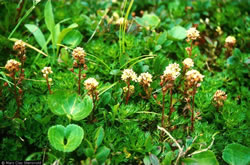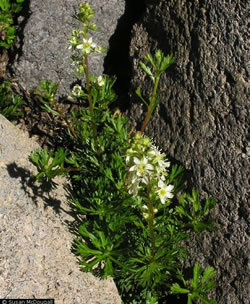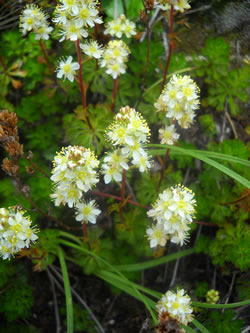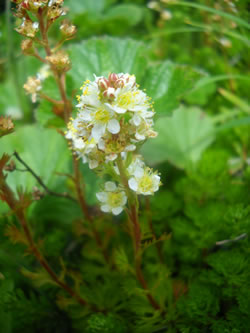Plant of the Week
 Luetkea pectinata range map. USDA PLANTS Database.
Luetkea pectinata range map. USDA PLANTS Database.
 Luetkea pectinata in flower, Montana. Photo by Peter Lesica.
Luetkea pectinata in flower, Montana. Photo by Peter Lesica.
 Luetkea pectinata. Photo by Mary Stensvold, USDA PLANTS Database.
Luetkea pectinata. Photo by Mary Stensvold, USDA PLANTS Database.
 Luetkea pectinata. Photo by Susan McDougall, USDA PLANTS Database.
Luetkea pectinata. Photo by Susan McDougall, USDA PLANTS Database.
Partridge-foot (Luetkea pectinata)
By Walter Fertig
The leaves of Partridge-foot (Luetkea pectinata) are wedge-shaped in outline but are deeply dissected into three sets of linear leaflets that superficially resemble the three toes of a game bird. These leaves are densely crowded in a basal rosette above a short, woody rootstalk. The plant’s woody base is too short to qualify it as a shrub, but too ligneous to be an herb, so botanist’s classify it as a subshrub or semi-shrub. Individual clusters of basal leaves are connected at or below ground level by woody rhizomes and stolons, allowing the Partridge-foot to form extensive, bright green mats. Slender, leafy stems rise 4-6 inches above the basal mat and are topped by a dense, spike-like raceme of white, 5-petaled rose-like flowers.
Partridge-foot is the only member of the genus Luetkea, which commemorates Count Luetke, a Russian captain and explorer of the early 1800s who mapped the coastline of Alaska. When originally described, Partridge-foot was thought to be saxifrage (Saxifrageaceae), but its true affinity with the rose family (Rosaceae) was later recognized. The species occurs primarily in subalpine or alpine habitats with deep and long-persisting snow banks from Alaska and Yukon south in the Cascades and northern Rocky Mountains to northern California, Alberta, Montana, and Idaho. Its ability to spread by rhizomes is an important adaptation for growing in late snowmelt areas where the growing season may be too short for flowering and fruit ripening. Gardeners have taken advantage of Partridge-foot’s facility for vegetative spread to introduce the species into cultivation in warmer climates, though it still does best in cool, semi shady settings, or well-watered rock gardens.



